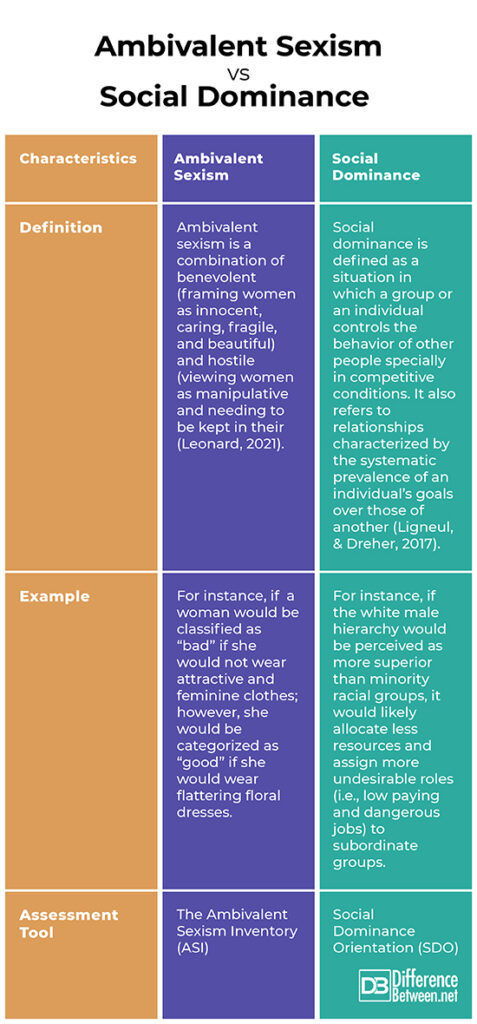Difference Between Ambivalent Sexism and Social Dominance
Both ambivalent sexism and social dominance involve prejudice and discrimination; they view certain groups of people as inferior. Specifically, ambivalent sexism views women as good or deceitful, depending on the situation. On the other hand, social dominance is defined as a situation in which a group or an individual controls the behavior of other people specially in competitive conditions. The following discussions further delve into their differences.

What is Ambivalent Sexism?
Ambivalent sexism is a combination of benevolent (framing women as innocent, caring, fragile, and beautiful) and hostile (viewing women as manipulative and needing to be kept in their place) sexism. Depending on the situation, it sees women as good or deceitful (Leonard, 2021). For instance, a woman is classified as “bad” if she is not wearing attractive and feminine clothes; however, she would be categorized as “good” if she would wear flattering floral dresses.
Instead of viewing benevolent and hostile sexism as conflicting ideologies, ambivalent sexism theory proposes that they are complementary which resolves the gender relationship paradox. Through benevolent sexism, men offer masculine protection to women. In exchange, women, who are seen as innocent participants in their own suppression, comply; thus, preventing apparent coercion (Connor et al., 2016).
The Ambivalent Sexism Inventory (ASI) measures an individual’s benevolent and hostile sexism towards women. It has 22 items with the following sample items (Glick, & Fiske, 1996):
- No matter how accomplished he is‚ a man is not truly complete as a person unless he has the love of a woman. (Benevolence)
- Many women are actually seeking special favors‚ such as hiring policies that favour them over men‚ under the guise of asking for “equality”. (Hostility)
- In a disaster‚ women ought not necessarily to be rescued before men. (Benevolence; reversed scoring)
- Most women interpret innocent remarks or acts as being sexist. (Hostility)
- Women are too easily offended. (Hostility)

What is Social Dominance?
Social dominance is defined as a situation in which a group or an individual controls the behavior of other people specially in competitive conditions. It also refers to relationships characterized by the systematic prevalence of an individual’s goals over those of another (Ligneul, & Dreher, 2017).
The social dominance theory, proposed by Jim Sidanius and Felicia Pratto in 1999, aims to explain why and how social structures are guided by silent group hierarchies based on various traits. The different hierarchies may be based on characteristics such as gender, economic status, and race. Apparently, such pyramids affect the equity of resource allocations and role distributions. For example, if the white male hierarchy is more superior than minority racial groups, it will likely allocate less resources and assign more undesirable roles (i.e., low paying and dangerous jobs) to subordinate groups (Hawks, 2022).
The social dominance orientation (SDO) evaluates an individual’s support for hierarchies and beliefs if one’s own group should dictate other groups. Those who score high in SDO tend to believe that some groups should have more power and resources while other groups will just have to be situated at the bottom of the pyramid. On the other hand, those with low SDO tend to value equality; they believe that there should be no particular group that overshadows others (iresearchnet, 2022).
The SDO-7 scale evaluates social dominance orientation; it has two dimensions with eight items each: dominance and anti-egalitarianism. The following are the sample items (Ho et al., 2015):
Dominance
- It’s probably a good thing that certain groups are at the top and other groups are at the bottom.
- An ideal society requires some groups to be on top and others to be on the bottom.
- Some groups of people are simply inferior to other groups.
Anti-Egalitarianism
- We shouldn’t try to guarantee that every group has the same quality of life.
- It is unjust to try to make groups equal.
- Group equality should not be our primary goal.
Difference between Ambivalent Sexism and Social Dominance
Definition
Ambivalent sexism is a combination of benevolent (framing women as innocent, caring, fragile, and beautiful) and hostile (viewing women as manipulative and needing to be kept in their (Leonard, 2021). Instead of viewing benevolent and hostile sexism as conflicting ideologies, ambivalent sexism theory proposes that they are complementary which resolves the gender relationship paradox (Connor et al., 2016). As for social dominance, it is defined as a situation in which a group or an individual controls the behavior of other people specially in competitive conditions. It also refers to relationships characterized by the systematic prevalence of an individual’s goals over those of another (Ligneul, & Dreher, 2017).
Example
One example for ambivalent sexism is when a woman would be classified as “bad” if she would not wear attractive and feminine clothes; however, she would be categorized as “good” if she would wear flattering floral dresses. In comparison, an example for social dominance would be when the white male hierarchy would be perceived as more superior than minority racial groups and would likely allocate less resources and assign more undesirable roles (i.e., low paying and dangerous jobs) to subordinate groups.
Assessment Tool
The Ambivalent Sexism Inventory (ASI) measures an individual’s benevolent and hostile sexism towards women. On the other hand, the Social Dominance Orientation (SDO) evaluates an individual’s support for hierarchies and beliefs if one’s own group should dictate other groups.
Ambivalent Sexism vs Social Dominance

Frequently Asked Questions:
What is ambivalent sexism?
Ambivalent sexism is a combination of benevolent (framing women as innocent, caring, fragile, and beautiful) and hostile (viewing women as manipulative and needing to be kept in their place) sexism. Depending on the situation, it sees women as good or deceitful (Leonard, 2021).
What is an example of ambivalent sexism?
For instance, a woman is classified as “bad” if she is not wearing attractive and feminine clothes; however, she would be categorized as “good” if she would wear flattering floral dresses.
What is the difference between sexism and benevolent sexism?
Sexism is more general as it is defined as discrimination or prejudice based on gender or sex which typically affects women and girls.
What is ambivalent sexism inventory?
The Ambivalent Sexism Inventory (ASI) measures an individual’s benevolent and hostile sexism towards women. It has 22 items with the following sample items (Glick, & Fiske, 1996):
- No matter how accomplished he is‚ a man is not truly complete as a person unless he has the love of a woman. (Benevolence)
- Many women are actually seeking special favors‚ such as hiring policies that favour them over men‚ under the guise of asking for “equality”. (Hostility)
- In a disaster‚ women ought not necessarily to be rescued before men. (Benevolence; reversed scoring)
Summary
- Both ambivalent sexism and social dominance involve prejudice and discrimination; they view certain groups of people as inferior.
- Ambivalent sexism views women as good or deceitful, depending on the situation, while social dominance is defined as a situation in which a group or an individual controls the behavior of other people specially in competitive conditions.
- The Ambivalent Sexism Inventory (ASI) measures an individual’s benevolent and hostile sexism while the Social Dominance Orientation (SDO) evaluates an individual’s support for hierarchies.
- Difference Between Hematoma and Melanoma - February 9, 2023
- Difference Between Bruising and Necrosis - February 8, 2023
- Difference Between Brain Hematoma and Brain Hemorrhage - February 8, 2023
Search DifferenceBetween.net :
Leave a Response
References :
[0]Connor, R., Glick, P., & Fiske, S. (2016). The psychology of prejudice. Cambridge University Press.
[1]Glick P.‚ & Fiske S. T. (1996). The Ambivalent Sexism Inventory: Differentiating hostile and benevolent sexism. Journal of Personality and Social Psychology‚ 70(3)‚ 491–512.
[2]Hawks, D. (2022). Social dominance theory: Definition and examples. Study.com. https://study.com/academy/lesson/social-dominance-theory-definition-examples.html
[3]Iresearchnet. (2022). Social dominance orientation. Psychology. http://psychology.iresearchnet.com/social-psychology/group/social-dominance-orientation/
[4]Leonard, J. (2021). 6 types of sexism, examples and their impact. Medica News Today. https://www.medicalnewstoday.com/articles/types-of-sexism
[5]Ligneul, R., & Dreher, J. (2017). Decision neuroscience. Academic Press.
